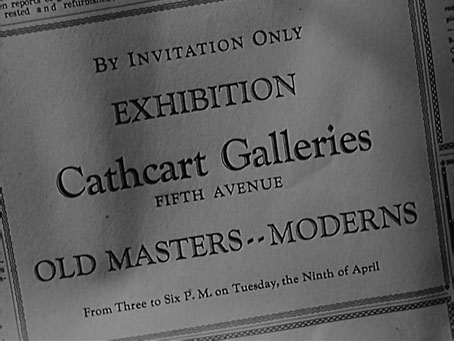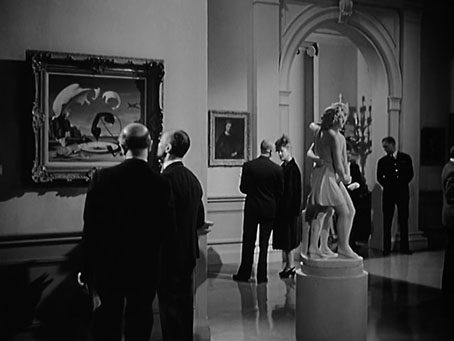
Continuing an occasional series about artworks in feature films with a post that suits a week where Surrealism has been a dominant theme.
I’ve been watching a lot of film noir recently, and I do mean a lot. Since August last year I’ve watched almost 100 films that warrant the label (I’ve been keeping a written record to avoid losing track), with more of them still to come. Many of these have been first-time viewings, an experience that’s been enlightening and mostly positive. I’ll have more to say on the subject in the future but for now here’s a discovery from The Dark Corner (1946), a detective drama directed by Henry Hathaway, and one I hadn’t seen before.
A Vermeer in a dark corner.
The story concerns a New York private eye, Bradford Galt (Mark Stevens), who’s being framed by parties unknown. When Galt investigates the mystery with his secretary, Kathleen (Lucille Ball in a straight role), their researches lead them to a Fifth Avenue art gallery run by Hardy Cathcart (Clifton Webb playing the same waspish aesthete as he did in Laura). Many of the art details can’t help but seem amusing or bizarre today, such as when someone brings home a genuine Vincent van Gogh painting and leaves it propped in a chair. There’s also a painting that we’re told is a rare Raphael but since this has to resemble Cathcart’s wife it looks nothing like a Renaissance picture. Elsewhere, a Donatello statue is priced at a mere $40,000, while Cathcart has Vermeer’s Girl with a Pearl Earring on sale despite the real painting having been in the collection of the Mauritshuis in The Hague since 1902.
As to the Surrealism, a scene inside the gallery features a blink-and-you-miss-it moment when a pair of would-be purchasers are seen peering at this Salvador Dalí painting, one of the few pieces of contemporary art on display. Before the camera pans away we see the man on the right shaking his head. I think this painting was also created for the film but unlike the alleged Raphael it looks genuine, and resembles several pictures that Dalí painted in the 1930s (eg: this one), all of which feature telephone receivers. The choice of imagery is apt. Two years earlier Dalí had created a seven-picture sequence illustrating “The Seven Lively Arts”. The Art of Cinema is represented by a figure whose head is a giant eyeball positioned between two huge ears, and with eyelashes that are cords leading to yet more telephone receivers.
Imitation or not, the painting in The Dark Corner did at least end up on the screen. In 1946 Dalí was working with Disney’s animators on the Destino project but the results of this wouldn’t be seen for another 50 years. I’ve been wondering what other Dalínean references might be hiding in American feature films from this time. (Don’t say Spellbound, everybody knows that one…)
Previously on { feuilleton }
• Art on film: Je t’aime, Je t’aime
• Art on film: Space is the Place
• Art on film: Providence
• Art on film: The Beast



Fantastic topic for me, as a near-lifelong fan of Film Noir. I hope to see more writing on the topic from you, and with the intensive viewing schedule you’ve undertaken you really have no excuse not to write about them now ;o).
“Dark Corner” is a pretty great example of the genre; I rated it an 8 out of 10 stars after my watch. I enjoy the glimpses of interior design we sometimes get in films from the ’40s; with the modern (or “moderne”) sets being particular favorites.
this is a 20th century fox movie, so the large white reclining late-art-deco statue in the middle of the gallery main room appear on 1953 ‘how to marry a millionaire’ Lauren bacall’s balcony , also by fox. perhaps looking into more fox movies will lead to their recurring art treasures
Jim: Yes, I enjoyed this one. Henry Hathaway had a terrible reputation for bullying his actors but his films are generally worthwhile. I have a couple of noir-related posts in mind but it’ll be some time before I write anything.
Hagai: Thanks for the tip!
might eyes recommend a few too many more
Thanks, if you mean this list https://boxd.it/liQ4A then that’s rather more than I require. I also put limits on what I’d class as noir, something that becomes fraught with regard to neo-noir where there’s a lot of pastiche going on.
My definition is following the one detailed in Film Noir: An Encyclopedia Reference to the American Style by Alain Silver and Elizabeth Ward; I’ve also been watching their list of 300 essential films as given in the first edition (I think they may have expanded this in more recent editions). You’d have to read their essays to see how they define the genre but they make the point that there has to be a kind of philosophical or psychological dimension to the story beyond the visual appearance or other details. Not every detective picture is noir, not everything with a femme fatale is noir, and not all noir includes either of those characters. This is all very subjective but then it’s always been a slippery genre.
What an art connection this movie has! Besides Vermeer and Van Gogh, there’s JMW Turner, Donatello, and Raphael. Then there’s the interactive sequence in the latter portion of the film with the 2 main characters sitting down and chatting. The camera reveals (briefly) in the background a very famous painting. While the viewer is pondering in their mind, is that what I think it is, Brad Galt says, “I can be framed easier than Whistler’s Mother”! The timing is perfect and our answer is given! If only an art expert would watch this movie and reveal some other paintings we may have missed!